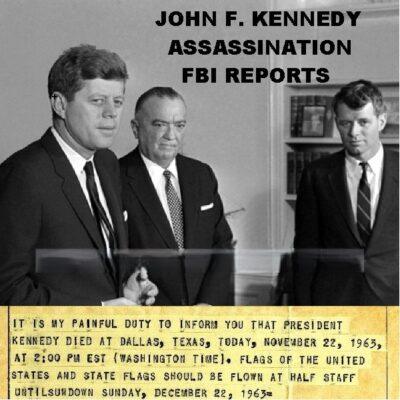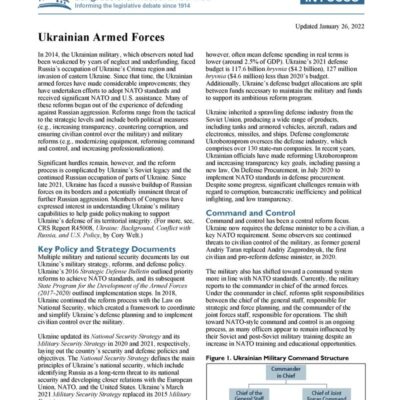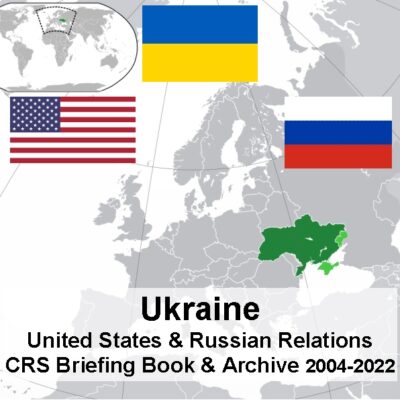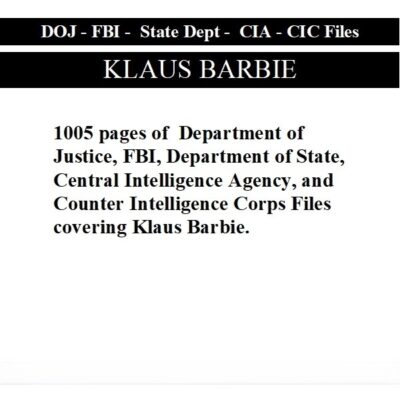
Clifford Berryman’s Political Cartoons from World War II
$19.50
Description
World War II: Political Cartoons by Clifford Berryman
This collection features 390 original pen-and-ink drawings along with 410 pages of commentary related to World War II, created by the esteemed political cartoonist Clifford K. Berryman, who was awarded the Pulitzer Prize for his work.
This compilation stands out as one of the most valuable resources for observing both global and national developments during the ascent of fascism in Europe during the 1930s. It also captures America’s response to the events leading up to the war in the latter part of that decade, as well as the nation’s eventual involvement in World War II. The final stages of the conflict can also be explored through the cartoons in this collection.
The images included are not merely reproductions of the cartoons as they were published in the Washington Evening Star; rather, they are duplicates of the original pen-and-ink artworks that served as templates for the printed versions. Each illustration is accompanied by a cover sheet, many of which provide detailed explanations about the background and themes depicted in the image.
Berryman’s early warning regarding potential trouble in Germany can be traced back to a cartoon he created in January 1923 titled “Twixt the Devil and the Deep Sea.” At that time, the German government was grappling with discontent among its citizens, who were frustrated by what they perceived as the unjust conditions imposed by the Treaty of Versailles. Simultaneously, there were looming threats from the French to invade the Ruhr region, claiming that Germany had fallen behind on its reparation payments.
Examples of Illustrations Include:
“President-Chancellor Hitler Proposes to Get His Opponents into Line by Loving Methods” Published: September 20, 1934

“Comrade, This War Makes Strange Bedfellows, Doesn’t It?” Published: September 24, 1939
As tensions escalated in Europe and the threat to America grew, politicians from both major parties united in their calls for increased American preparedness. In this context, Berryman’s cartoon highlights the unusual alliance formed between Hitler and Stalin, illustrating how crises can create unexpected partnerships.
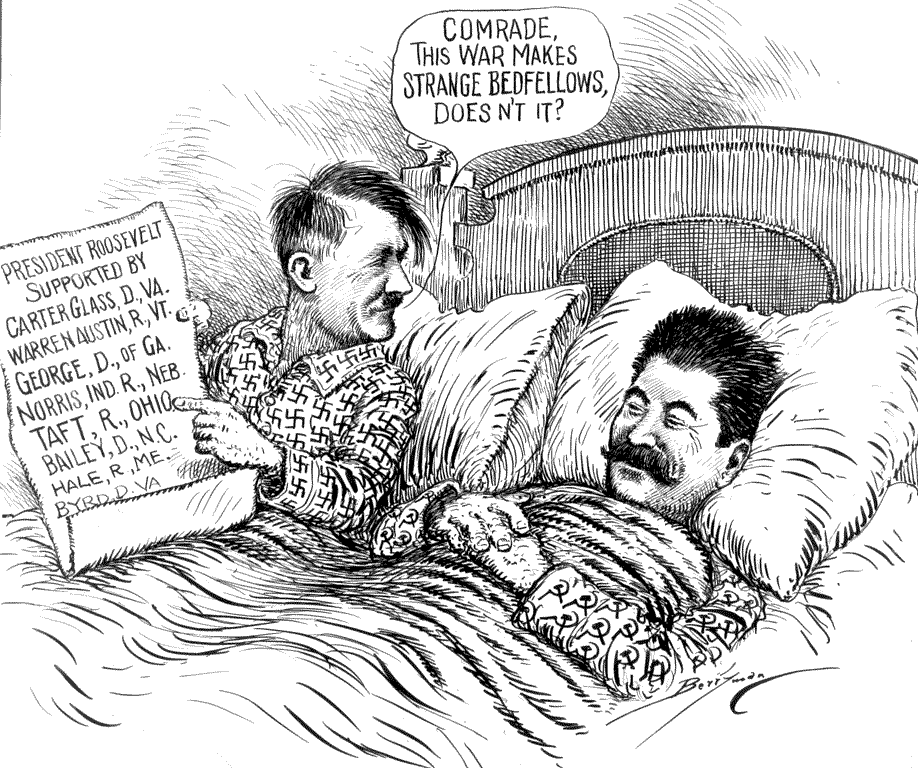
“Aid to Britain” Published: March 7, 1941 The illustration depicts Winston Churchill in a wrestling ring, where he is being viciously attacked by figures representing Japan (potentially Emperor Hirohito), Mussolini, and Hitler. Behind the ropes stand Clark, Wheeler, and Nye, who are throwing various accusations at Churchill and Great Britain regarding their wartime actions.
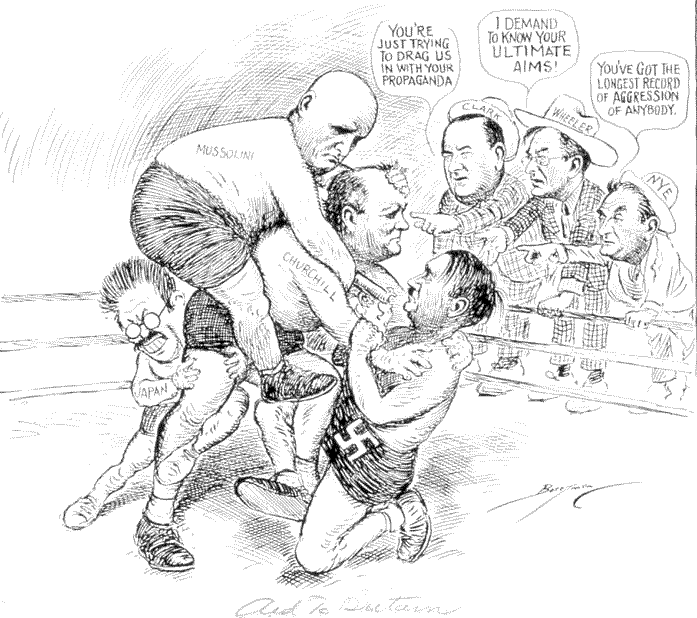
The cartoon titled “I Didn’t Say You Could Keep It,” published on June 20, 1941, portrays Joseph Stalin as a content black bear sitting in front of a beehive labeled with the names of Eastern European nations: Estonia, Latvia, Bessarabia, Lithuania, and Ukraine. In this scene, Hitler approaches Stalin holding a bucket and a large spoon. The backdrop of this interaction is the Nazi-Soviet Pact of 1939, which allowed the Soviet Union to assert its influence over several eastern European countries along its western border. However, by the spring of 1941, the relationship between Germany and the Soviet Union was beginning to deteriorate significantly. Just two days after this cartoon’s publication, Hitler launched an invasion of the Soviet Union.
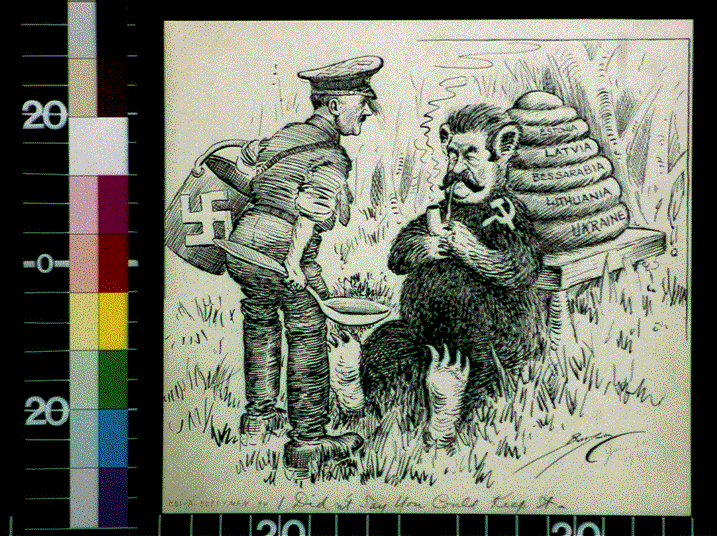
In the cartoon titled “And There’ll Be Many Happy Returns of the Day,” released on April 20, 1943, coinciding with Hitler’s birthday, we see him cowering beneath an intense barrage of bombs. One notably large bomb carries a tag that reads, “Birthday Greetings to Der Fuehrer — R.A.F. [and] U.S.A.A.F.” By this time, in April 1943, British and American bombers were relentlessly attacking Germany almost every day. The artist, Berryman, implies that these bombings serve as a fitting birthday gift for the German leader.
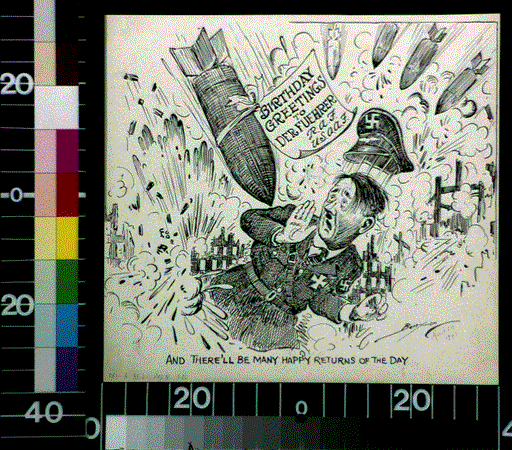
Finally, the cartoon named “Atomic Bomb Report,” dated August 8, 1945, features Secretary of War Henry Stimson presenting President Truman with a report titled “Greatest Achievement of the Combined Efforts of Science, Industry, Labor and the Military in All History.” In a contrasting depiction, a scared caricature of John Q. Public appears, raising the concern of “How to Make People Be Decent to Each Other” and pleading with Truman to “P-p-p-lease Make Those Scientists Solve This One Real Q-q-q-q-quick!” The cartoon captures the anxiety surrounding the implications of the atomic bomb and the hope for

Berryman’s Cartoons: A World War II Timeline
- January 1923: Clifford Berryman draws a cartoon titled “Twixt the Devil and the Deep Sea,” highlighting the German government’s challenges with the Treaty of Versailles and the French threat to invade the Ruhr. This marks an early recognition of brewing tensions in Europe.
- September 20, 1934: Berryman publishes a cartoon titled, “President-Chancellor Hitler Proposes to Get His Opponents into Line by Loving Methods”, referencing Hitler’s consolidation of power in Germany.
- September 24, 1939: Berryman publishes “Commrade This War Makes Strange Bedfellows, Does n’t It?”, depicting the cynical alliance between Hitler and Stalin through the Nazi-Soviet Pact, and referencing how the war brought unusual political alliances and partnerships.
- March 7, 1941: Berryman publishes “Aid to Britain”, showing Winston Churchill being attacked in a wrestling ring by Japan (possibly Hirohito), Mussolini, and Hitler, while isolationist US politicians like Clark, Wheeler, and Nye stand on the sidelines.
- June 20, 1941: Berryman publishes “I Didn’t Say You Could Keep It,” depicting Stalin, represented as a bear, sitting on territories annexed through the Nazi-Soviet Pact, while Hitler approaches him with a spoon, symbolizing Germany’s upcoming invasion of the Soviet Union.
- April 20, 1943: Berryman publishes “And There’ll Be Many Happy Returns of the Day”, showing Hitler under attack from Allied bombers (RAF and USAAF) on his birthday.
- August 8, 1945: Berryman publishes “Atomic Bomb Report,” depicting Secretary of War Henry Stimson showing President Truman a report on the atomic bomb, while John Q. Public expresses fear and asks for a quick solution to peaceful coexistence, following the devastating bombing of Japan.
Cast of Characters
- Clifford K. Berryman: A Pulitzer Prize-winning American political cartoonist for the Washington Evening Star. The cartoons are the source material for this document. He used his political cartoons to comment on international and domestic events.
- Adolf Hitler: The dictator of Nazi Germany, depicted in multiple cartoons as the primary antagonist. The source refers to the rise of his power, his alliance with Stalin, and eventually, his defeat.
- Joseph Stalin: The leader of the Soviet Union, portrayed in one cartoon as a bear enjoying the spoils of the Nazi-Soviet Pact, and later is threatened by the actions of Hitler.
- Winston Churchill: The Prime Minister of the United Kingdom, depicted in the “Aid to Britain” cartoon as being attacked by Axis powers. The cartoon depicts support to the British and implied sympathy to his position.
- Hirohito (implied): The Emperor of Japan, possibly represented in the cartoon “Aid to Britain” as one of the figures attacking Churchill.
- Benito Mussolini: The dictator of Italy, depicted in the “Aid to Britain” cartoon as part of the group attacking Churchill.
- Clark, Wheeler, and Nye: U.S. Senators known for their isolationist views, depicted in “Aid to Britain” as figures standing on the sidelines while the war rages in Europe. Their political views are being referenced in their portrayal.
- Harry S. Truman: The President of the United States at the end of World War II, depicted in the “Atomic Bomb Report” cartoon receiving the report on the atomic bomb from Henry Stimson, and facing the fear and concern of the American public.
- Henry Stimson: The U.S. Secretary of War, depicted in the “Atomic Bomb Report” cartoon presenting the report of the atomic bomb to President Truman.
- John Q. Public: A symbolic representation of the American public, depicted as a fearful individual in the “Atomic Bomb Report” cartoon, expressing the need for world peace and peaceful coexistence.

